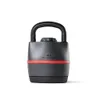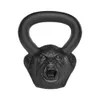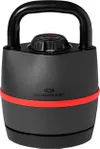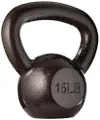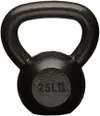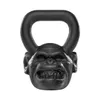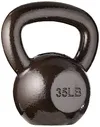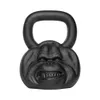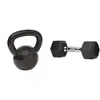
Recently, the thruster exercise took up full-time residence in my apartment — this fitness challenge involved me, two medium-weight kettlebells and one of my favorite full-body exercises to program for others. If you’re looking for one move that ticks boxes for efficiency, look no further than the thruster.
To do thrusters, you’ll need a barbell or set of the best kettlebells or dumbbells for weightlifting. In this instance, I opted for kettlebell dual rack thrusters, meaning I loaded both sides of my body together.
The full-body resistance exercise combines a racked squat with an overhead press, helping you target the upper and lower body while using your core muscles to help drive movement and stabilize the body during weightlifting. Here’s what happened when I practiced them for a week.
How to do kettlebell thrusters
How:
- Stand with your feet hip or shoulder-width apart
- Rack your kettlebells onto your shoulders with both elbows slightly forward. Here’s how to perform kettlebell cleans if you want to learn to load safely
- Engage your core by bracing your stomach and slightly bearing down
- Perform a squat while keeping your spine neutral and chest lifted
- Push your knees outward and keep the weight mid-foot to heel
- Drive through your legs to stand and press your kettlebells overhead
- Push your head slightly through your arms and keep your weights aligned with your shoulders to keep them stable
- Bend your knees and elbows as you lower your weights safely back to your shoulders and move straight into a squat
- Keep the elbows slightly lifted as you catch the bells onto your shoulders
I did 50 kettlebell thrusters every day for one week, and here’s what happened
Here's what I learned.
Days 1 and 2: Ouch
First and foremost, if you don’t have thrusters in the bank yet, don’t rush into repping them out every day. Program with caution and enough rest for your muscles — this looks different for everyone. I know people who use the “bro split” characterized by splitting your muscle groups up by the days of the week (Monday for chest, Tuesday for back and so on), others train 3-5 days a week with varying intensities, and I also know gym-goers who hit CrossFit workouts every day without a problem.
How you dial into your training program is down to you. Still, if you’re new to exercise, pre or post-natal, or returning from injury, I don’t recommend jumping into any exercise for high reps every day of the week — listen to your body, and if there’s pain, stop.
Sign up to get the BEST of Tom's Guide direct to your inbox.
Get instant access to breaking news, the hottest reviews, great deals and helpful tips.
I find thrusters insanely tough. Although I’ve gotten stronger and more capable over the years, I still groan when I see them on the menu at CrossFit. And I can’t pinpoint why, so you might wonder why I chose them daily for a challenge. I firmly believe you should meet with things that make you uncomfortable from time to time, and learn to embrace them. So here we are. And for the first few days of this challenge, I can only say — ouch.
Days 3 and 4: I used preparation exercises
I have limited mobility in my knees and ankles and previously struggled with butt-winking when I very first started lifting weights. To prepare myself properly for kettlebell thrusters, I warmed up using a combination of squats, lunges and dynamic full-body stretches that also worked my lower body through a range of motion; this helped me find better depth in the squat position before loading with kettlebells and helped my hips adjust to the exercise.
Approaching the midway point, my legs and core muscles were dealing well, but my shoulders (my weakest muscle group) were working double time. If you experience significantly different levels of strength between your upper and lower body (like many people), finding weights that suit thrusters can be trickier.
I recommend using weights you can press overhead while keeping your trunk stable rather than loading heavy just because your legs can take it. Thrusters are a brilliant exercise at testing full-body strength as you’ll have to deal competently with shifting the load from lower to upper body and back again without your stronger side taking slack.
Days 5 and 6: I mixed it up
Until day five, I had found the reps tiring, but my body was handling them fine (surprisingly), and aside from some next-day muscle soreness, I didn’t feel much different.
I had stuck to 50 reps — five sets of 10 reps, taking rest between sets — and hadn’t been adding enough intensity. For the remaining days, I programmed the reps as an EMOM, performing 10 heavy reps on the minute, every minute, for five rounds as a workout finisher instead. This time, I felt torched and had got what I came for — a challenge. I didn’t lift heavier weights than before (it takes longer than a week to move up and adjust load), but I did manipulate other variables like rest (here are 5 ways to build muscle without lifting heavier weights if you're interested in adding intensity in other ways).
Day 7: Verdict
The process of building muscle (known as hypertrophy) takes months to develop, not a week, and the same goes for building strength. So while I've experienced some muscle soreness, I haven't exactly gone through a process of body recomposition.
But, I have spent time going face to face with one of my favorite exercises to program and least favorite to perform. And I feel less inclined to groan and back slowly out of the room when the move inevitably crops up again in my workout programs. I've possibly tightened up my form, too.
More from Tom's Guide
- Forget planks, this dumbbell abs workout builds core strength
- Forget deadlifts — 3 kettlebell exercises that build full-body muscle in just 15 minutes
- Forget push-ups, you just need 1 kettlebell and 15 minutes to build your chest, shoulders and legs

Sam Hopes is a level 3 qualified trainer, level 2 reiki practitioner and senior fitness writer at Tom's Guide. She is also currently undertaking her Yoga For Athletes training course. Sam has written for various fitness brands and websites over the years and has experience across brands at Future such as Live Science, Fit&Well, Coach, and T3.
Having worked with fitness studios like F45 and Virgin Active, Sam now primarily teaches outdoor bootcamps, bodyweight, calisthenics and kettlebells. She also coaches mobility and stretching-focused classes several times a week and believes that true strength comes from a holistic approach to training your body.
Sam has completed two mixed doubles Hyrox competitions in London and the Netherlands and finished her first doubles attempt in 1:11.
